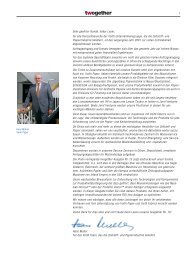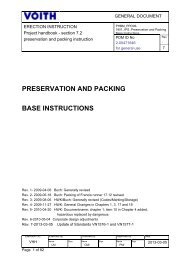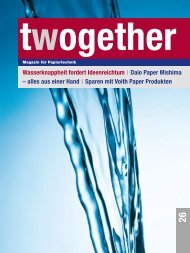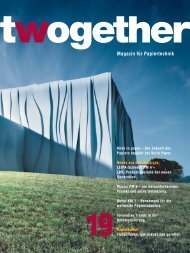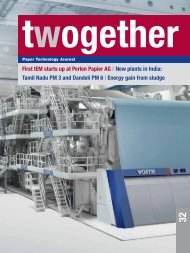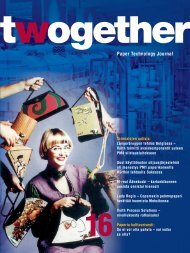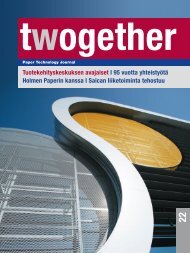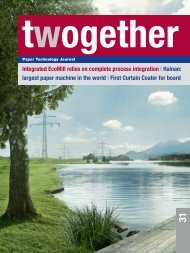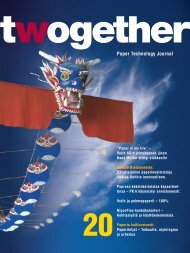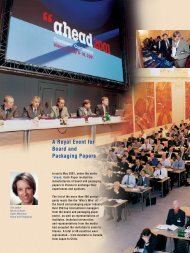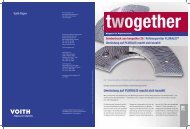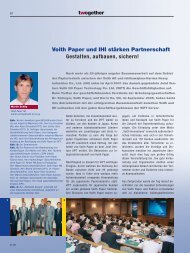Create successful ePaper yourself
Turn your PDF publications into a flip-book with our unique Google optimized e-Paper software.
epeatedly into the paper suspension in a<br />
particular rhythm, so that the fibres are<br />
distributed uniformly.<br />
One of the secrets of Washi production is<br />
adding Neri to the paste. This viscous<br />
root sap from the Japanese hibiscus<br />
plant links the paper fibres together, improves<br />
sheet formation and permits wet<br />
sheets to be stacked. The sheets are<br />
dried by pressing and then individually<br />
brushed on to Gingko wood boards. During<br />
the drying process it is this wood that<br />
gives paper its special gloss, an effect<br />
that becomes stronger as the paper ages.<br />
Washi is never bleached unless by exposure<br />
to natural sunlight. The fibres get<br />
their colour solely from the washing and<br />
cleaning processes.<br />
<strong>Paper</strong>making by this method is a burdensome<br />
task. Those involved have to work<br />
in a constant stooped or standing position<br />
for many hours with their hands in<br />
icy water. To master each step in the<br />
process, budding papermakers need four<br />
to six years of training. Although wholesalers<br />
have to pay as much as 80 Euro<br />
for one single sheet of this paper, the<br />
employees hardly ever earn more than 8<br />
Euro per hour. This is one of the reasons<br />
why traditional Japanese small-scale craft<br />
trades have had difficulty for some years<br />
in recruiting young people – despite a lot<br />
of advertising for this profession through<br />
job centres and the visits to schools by<br />
master papermakers, and despite exhibitions<br />
in museums and even theme parks<br />
on the subject of papermaking.<br />
In many regions the traditional papermakers<br />
have had to become highly specialized<br />
in order to outperform industrial<br />
products and locate market niches. In the<br />
Gifu Prefecture, for example, the emphasis<br />
is on “Amime” paper: This networkstyle<br />
Washi is created by water jets perforating<br />
the fibres on the bamboo screen.<br />
This paper is mainly used for decorative<br />
purposes.<br />
Hosho paper is particularly thick and<br />
soft. In the Echizen region this grade was<br />
used to produce Japan’s first national<br />
paper money, because it does not shrink<br />
and is resistant to tearing. Nowadays it is<br />
67<br />
mainly used for wood etchings. Several<br />
famous painters, for example Taikan<br />
Yokoyama, order large-format Washi<br />
sheets from Echizen. They use them for<br />
Sumi-e (watercolour paintings) and calligraphy.<br />
The museum in Imadate, which<br />
is also located in the Echizen region, contains<br />
the world’s largest hand-skimmed<br />
sheet of paper: 7.1 x 4.3 meters – over<br />
30 square metres of Washi in a single<br />
piece.<br />
Of course, it was not a Goddess but<br />
Korean monks who took the art of papermaking<br />
to Japan. The Japanese Emperors<br />
invited the first monks over from the<br />
Korean peninsula in the 5th century, because<br />
they wished to distribute Buddha’s<br />
transcripts on paper all over the country.<br />
The common people were encouraged to<br />
grow mulberry trees to ensure an adequate<br />
supply of raw material. In the<br />
eighth century the Japanese began to refine<br />
the Korean technology when they<br />
discovered Gampi as a raw material, a<br />
plant indigenous to Japan. Gampi fibres<br />
are noted for their exceptional fineness<br />
and natural viscosity. With the aid of this<br />
<strong>17</strong>/04<br />
4



